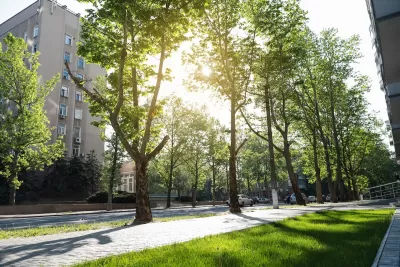A new national tree canopy assessment tool, available at TreesAtWork.org, provides high-resolution data to help cities track tree cover changes, prioritize planting efforts, and enhance urban resilience.

A new national tree canopy assessment tool is now available, providing cities across the U.S. with high-resolution data to evaluate local and regional tree cover and track changes over time. As urban areas face increasing challenges from extreme heat, storms, and air pollution, this tool equips community leaders with essential insights to prioritize tree planting and protection efforts where they are needed most. Developed through a collaboration between the Arbor Day Foundation, PlanIT Geo, and the USDA Forest Service Urban and Community Forestry program, the tool enables users to analyze land cover statistics, urban development patterns, and tree canopy data down to the census block group level, fostering more strategic and equitable urban forestry initiatives.
Hosted at TreesAtWork.org, the platform will continue to expand with additional data and resources throughout 2025, including a National Baseline Canopy Assessment Report that will provide an in-depth analysis of urban tree canopy trends nationwide. By offering actionable intelligence on tree loss and investment impacts, the tool supports cities in making informed decisions to enhance climate resilience, improve air quality, and expand equitable green infrastructure. As Dan Lambe, CEO of the Arbor Day Foundation, emphasized, this tool represents a significant step toward shaping healthier, more sustainable communities through strategic urban forestry planning.
FULL STORY: New National Tree Canopy Assessment Tool Now Live

Study: Maui’s Plan to Convert Vacation Rentals to Long-Term Housing Could Cause Nearly $1 Billion Economic Loss
The plan would reduce visitor accommodation by 25,% resulting in 1,900 jobs lost.

North Texas Transit Leaders Tout Benefits of TOD for Growing Region
At a summit focused on transit-oriented development, policymakers discussed how North Texas’ expanded light rail system can serve as a tool for economic growth.

Why Should We Subsidize Public Transportation?
Many public transit agencies face financial stress due to rising costs, declining fare revenue, and declining subsidies. Transit advocates must provide a strong business case for increasing public transit funding.

How to Make US Trains Faster
Changes to boarding platforms and a switch to electric trains could improve U.S. passenger rail service without the added cost of high-speed rail.

Columbia’s Revitalized ‘Loop’ Is a Hub for Local Entrepreneurs
A focus on small businesses is helping a commercial corridor in Columbia, Missouri thrive.

Invasive Insect Threatens Minnesota’s Ash Forests
The Emerald Ash Borer is a rapidly spreading invasive pest threatening Minnesota’s ash trees, and homeowners are encouraged to plant diverse replacement species, avoid moving ash firewood, and monitor for signs of infestation.
Urban Design for Planners 1: Software Tools
This six-course series explores essential urban design concepts using open source software and equips planners with the tools they need to participate fully in the urban design process.
Planning for Universal Design
Learn the tools for implementing Universal Design in planning regulations.
Ascent Environmental
Borough of Carlisle
Institute for Housing and Urban Development Studies (IHS)
City of Grandview
Harvard GSD Executive Education
Toledo-Lucas County Plan Commissions
Salt Lake City
NYU Wagner Graduate School of Public Service





























